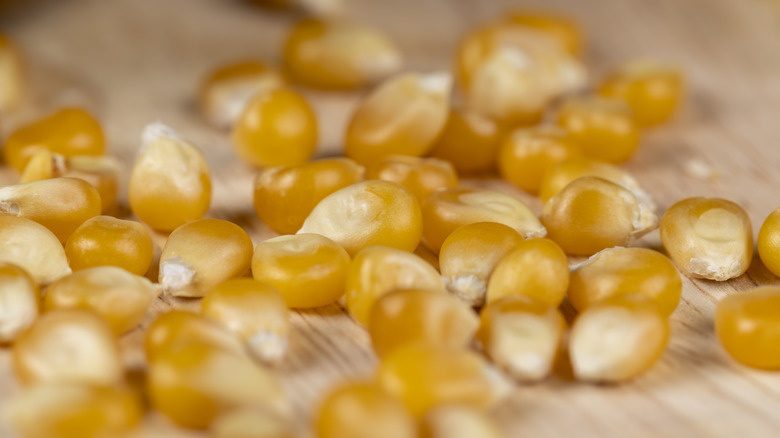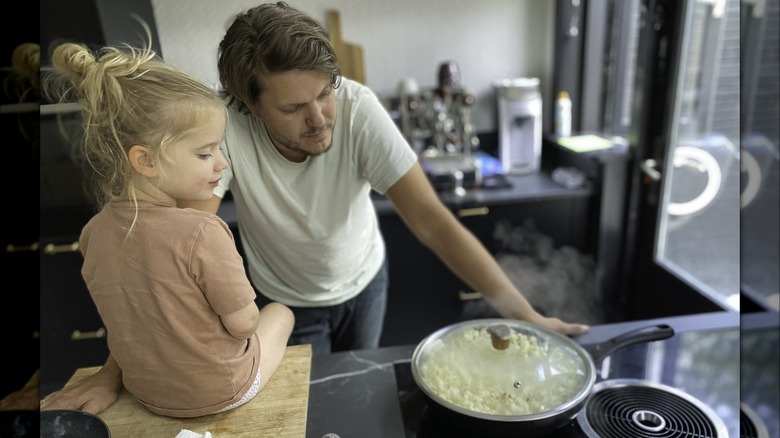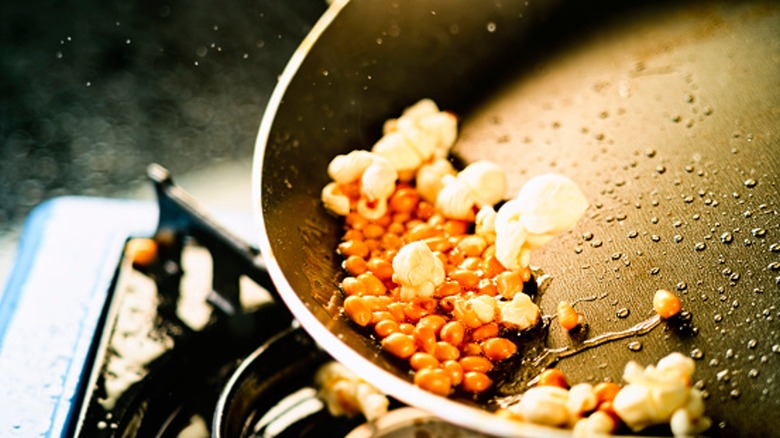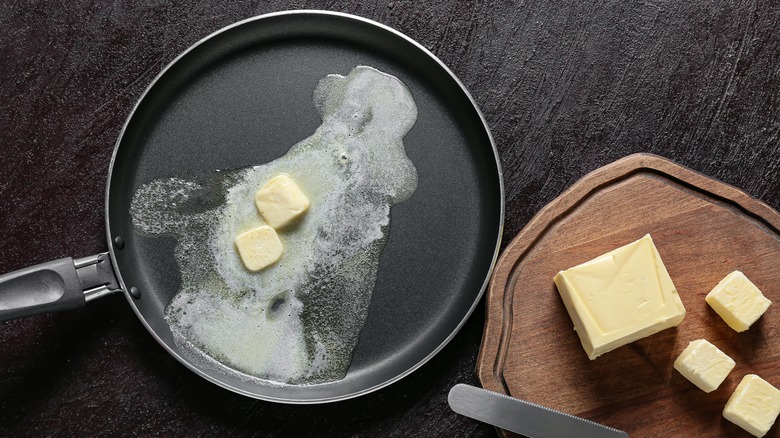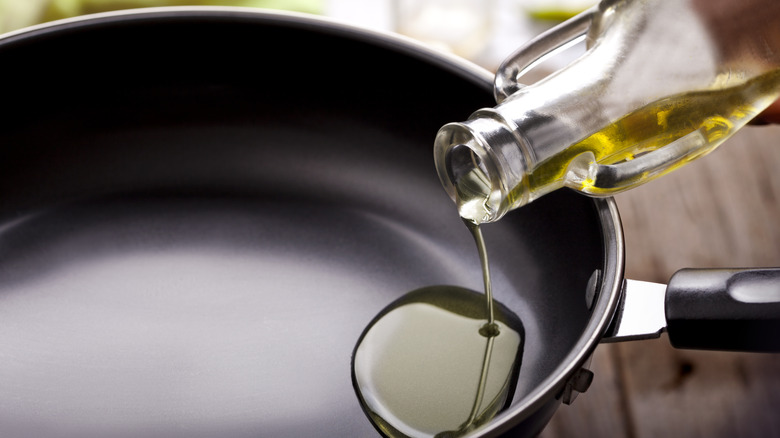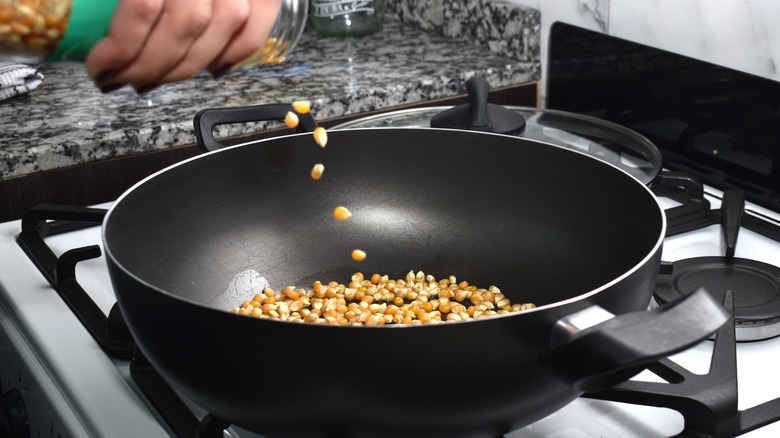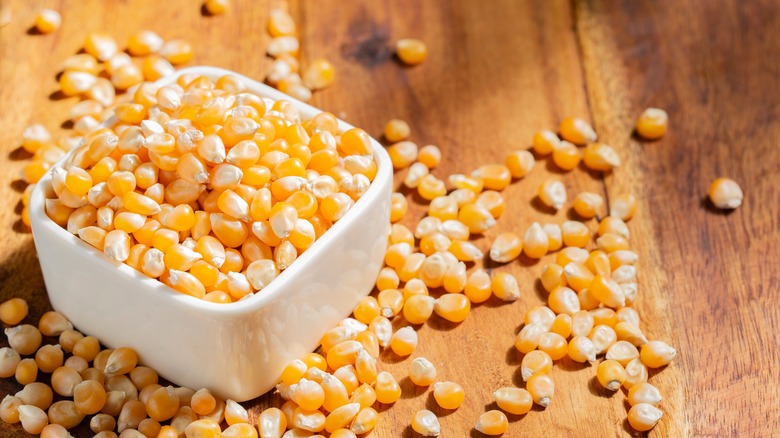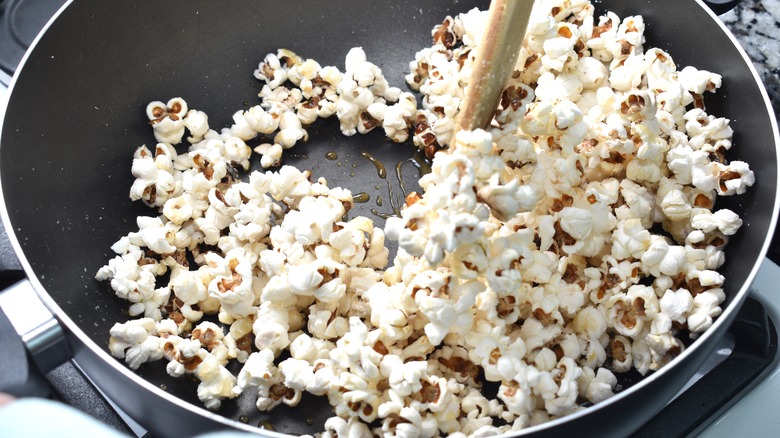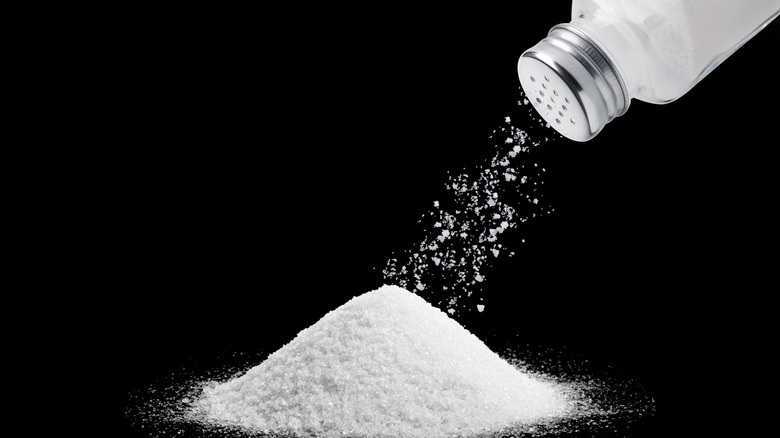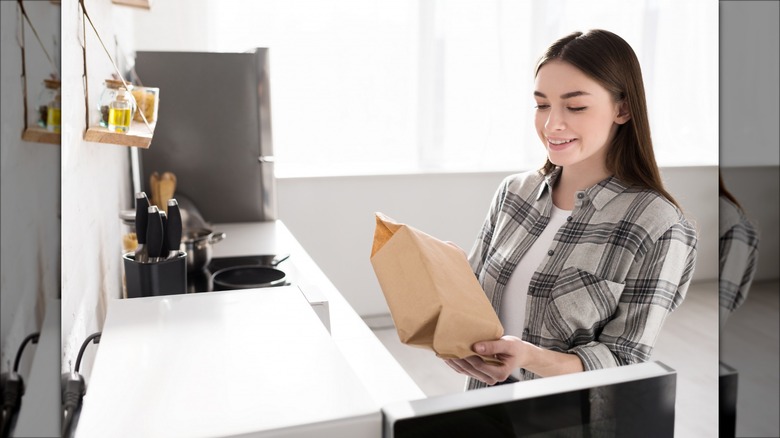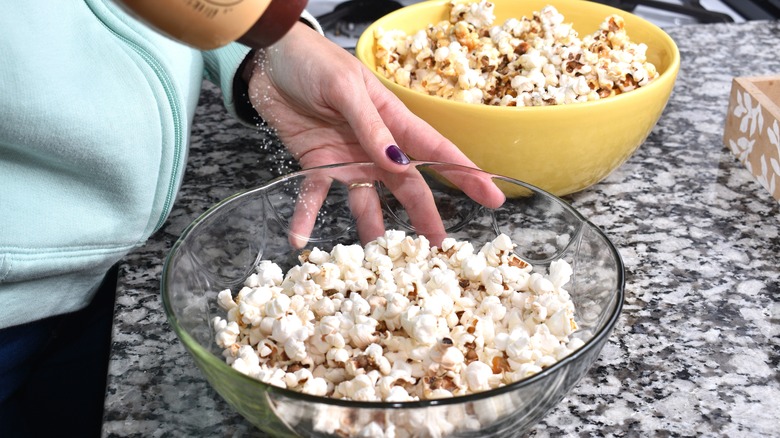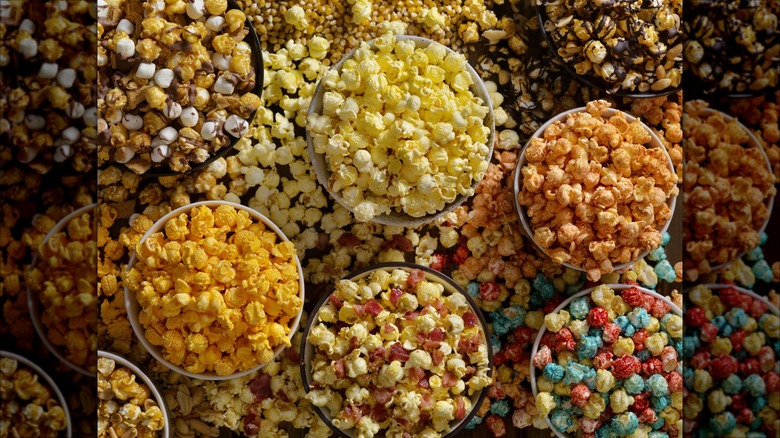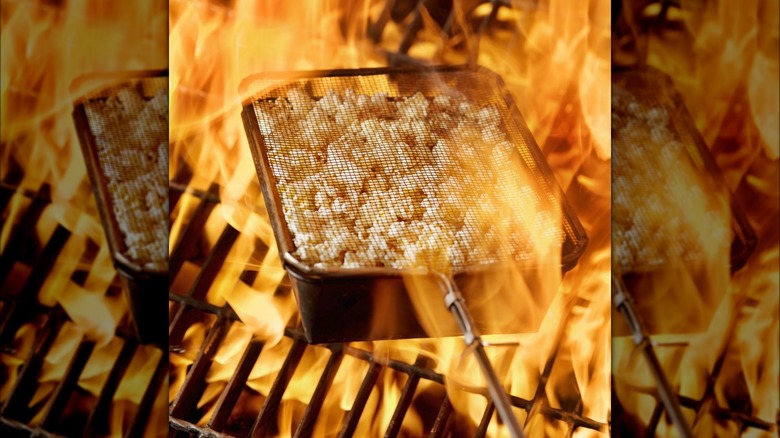13 Mistakes Everyone Makes When Popping Popcorn
We may receive a commission on purchases made from links.
Fresh popcorn right off the stovetop — or even directly out of the microwave — is a delicious treat. However, getting perfect light and fluffy popcorn isn't as straightforward as you might think. And, no one wants to have an evening snuggled next to their family, friends, partner (or pets) ruined by subpar popcorn. You might be surprised that there are several mistakes people often make when preparing a batch of beautifully buttery popcorn.
Depending on the mistakes you make, your popcorn could end up burnt, underseasoned, overseasoned, or worse. You may even be using the wrong type of oil for optimal popcorn. So, learning about the mistakes that people make when preparing popcorn is important if you want to avoid all of these potential problems. Read on to learn how to make sure your popcorn turns out with the right texture and is perfectly seasoned every time.
Using stale kernels
When you look at them, fresh and old popcorn kernels look very similar. However, assuming the old, stale kernels will yield popcorn of the same quality is a mistake that you'll only end up regretting. While popcorn kernels keep for a relatively long time, they will eventually turn stale and the popcorn they produce will suffer. You want to aim to use unpopped kernels within a year, though closer to six months would be even better. After this time, the popcorn you make will have more unpopped kernels mixed in.
What's more, the texture of the popcorn also won't be ideal. Kernels that are too old or haven't been stored properly lose moisture. If they do pop, the popcorn won't be as fluffy. You can minimize the loss of moisture through proper storage. Always keep your kernels in airtight containers.
It is also important to note that bags of microwavable popcorn don't always last as long as plain kernels. This is due to the oils that are added to these packages. If they aren't popped by the expiration date, the oil may go bad and negatively impact the taste of the popcorn once it is prepared.
Waiting for every kernel to pop
If you're making popcorn, you might have the mindset that you don't want to waste any kernels. However, waiting for every kernel to pop will be a mistake. Instead of just wasting the few unpopped kernels, you'll likely end up wasting much more. The problem is that as you're waiting for those last few kernels to pop, you're making it more likely for the rest of the popcorn to burn. It is essential to remove the popcorn from the pan once you're down to one to two seconds between pops. This means that most of the kernels are done and that there will only be a few that remain unpopped.
One good way to make sure all your kernels are of good quality is simply to buy a good brand. But, there are so many brands out there from Amish Country Popcorn to Orville Redenbacher's and so many types of kernels from mushroom to butterfly. So, this is likely to be a trial-and-error experiment for you. As you make popcorn on the stovetop at home, you may notice that some brands leave you with fewer unpopped kernels than others. Take note of which brands seem to perform better, and try to stick with them. However, with over 800 reviews on Amazon Bob's Red Mill has a 4.6 star rating with one claiming "Very few "old maids."
Wasting the old maids instead of trying to re-pop them
Those unpopped kernels in the bottom of the pot or your bowl of popcorn are often referred to as old maids. Moisture content is generally believed to be the reason that they didn't pop when you were preparing your treat. These kernels tend to have a lower moisture rate than their counterparts. However, just because the kernels didn't pop for you, it doesn't mean that you have to give up on them altogether.
Believe it or not, you can actually save these old maids from the trash can, and give them a second chance at a new life. After enjoying your bowl of popcorn, remove the old maids and put them in a mason jar. Pour in about 1 tablespoon of water before putting the lid in place. You'll want to make sure each kernel is coated with the water, so shake the jar a few times. Then, place the jar in the pantry for a few days before trying to repop the kernels. As they sit in the water, they should absorb enough of it to actually pop when you use them again.
Trying to pop in melted butter instead of oil
Buttery popcorn is so delicious. If you've been trying to pop your kernels in melted butter, we can definitely understand why you thought that might be a good idea. Unfortunately, it actually isn't something that you should do. You need to use high heat when making popcorn. Butter is just going to burn when exposed to the higher temperatures that are necessary for getting the kernels to pop.
Instead, you should always use oil when making popcorn on the stovetop. While any type of oil will technically work, it is best to choose one with a high smoke point. This way, you'll avoid the potential issue of burning your popcorn. While you might enjoy cooking with olive oil, it is not an ideal choice because of its lower smoke point. Instead, consider trying avocado oil, canola oil, coconut oil, or sunflower oil. All of these have a higher smoke point.
Not adding the correct amount of oil
Beyond using the right type of oil, it is also important to make sure you use the correct amount of oil. A good rule to follow is to add enough oil that it will coat the bottom of the pan. However, you don't want it to be so much that it pools up to a depth greater than 1 millimeter because the kernels will get too wet. Instead of popping as desired, it will have the effect of roasting them instead. They'll just cook slowly, and won't pop like you, obviously, want when making popcorn. Similarly, if you don't add enough oil, the kernels also won't pop as desired. You'll make it more likely for them to burn.
So, exactly how much oil should you be using when making popcorn? 3 tablespoons should be perfect for each ½-cup of kernels. Use a measuring spoon to make sure you add the correct amount so that you can avoid all the potential issues outlined above.
Adding the kernels to a cold pan
When you make popcorn, do you toss the kernels in as soon as you put the pan on the burner? If so, you've been making a mistake. It is essential to allow the pan to heat up before pouring in the kernels. If the pan isn't hot enough, the kernels are more likely to end up burnt, so this is a step you don't want to skip.
Fortunately, there is an easy way to make sure that the pot is hot enough before adding in all of the kernels. After adding the oil, drop just two or three kernels into the pan. Once they pop, you'll know that the oil is hot enough. At this point, you can confidently add the rest of the kernels that you have measured out. Another tip to prevent burning the popcorn is to make sure that you don't have the burner set too high. It should be set to about medium heat — any higher than this will get too hot.
Overestimating how many kernels you need
If you're planning a movie night, then you might want to make a lot of popcorn to make sure that you and your guests have plenty to snack on as you watch the TV. However, overestimating how many kernels you need could yield more popcorn than you'd ever be able to enjoy. It is important to remember that while the kernels don't take up much space in the bag or your measuring cup, that they will not be anywhere near the same size once they pop.
Just ¼ cup of popcorn kernels will make about 7 cups of popcorn. The average serving size for popcorn is between 4 and 5 cups. This means you would need just about 2 tablespoons of unpopped kernels for just one person. If you're having friends or family over and want to make enough to share, factor the number of people and the recommended serving size into account to help you decide how much to make.
Forgetting to shake the pan
Making popcorn on the stovetop is a bit of an art. One thing that you don't want to forget to do is to shake the pan around slightly while the kernels are popping. Gently shaking the pan periodically moves the kernels around and prevents them from sitting in the same place. This can help make sure that they don't end up burning during the cooking process.
However, while it is important to shake the pan a few times and move the kernels around, you don't want to be constantly shaking it about. Each time you shake the pan, you remove it from the heat of the burner. Without enough steady heat, your popcorn isn't going to pop as it should. Once you start hearing more and more kernels popping, there isn't much need to shake the pot anymore. At this point, the kernels will be moving themselves around some as those around them are popping.
Using your regular salt
There's a reason you see special popcorn salt at the grocery store. And, it isn't just to help the manufacturers make more money by selling you something else along with your kernels. What is popcorn without salt? Surely not something that most of us want to eat. However, popcorn salt is actually different from the regular salt you have in your pantry in one key way: its size.
The crystals in sea salt or kosher salt are much larger than those in popcorn salt. While this may not seem like a huge deal, it is when you consider that the larger crystals will just slide off the kernels. This means you aren't going to get the same salty flavor with each bite. The benefit of using popcorn salt is that the crystals are much smaller, so they can tuck themselves into all the little crannies on each popped piece. This delivers a much more satisfying ratio of salt to popcorn.
If you don't want to buy special popcorn salt, you can toss some of your regular sea salt or kosher salt into a food processor or grinder to break them into smaller pieces. However, this might end up being more work than just buying a small container of popcorn salt.
Setting the microwave and walking away
If you just picked up some groceries at Dollar Tree, you might be ready to break open that box of microwave popcorn and cook one bag right away. Pressing the popcorn button on your microwave and walking away to finish unpacking the rest of your groceries might sound like a great plan. After all, these machines wouldn't offer such a feature if it didn't work correctly, right? Unfortunately, that is not the case. The popcorn setting on most microwaves lasts for approximately 2 minutes and 30 seconds. For most bags of popcorn, relying on this setting will leave you with burnt popcorn.
If you're making microwave popcorn, you'll need to plan to stay right by the appliance while it cooks — especially after the first minute and a half. A timer can't tell you when your popcorn will be finished. Instead, you need to listen to the pops. Once the popping slows down, and you can count to two or three between pops, then it is time to turn off the microwave and remove the bag. Relying on a button or a timer is only going to leave you disappointed with the results.
Making the popcorn too far ahead of time
Don't make the mistake of preparing popcorn too far in advance. Unlike some other desserts, such as cookies or cakes, popcorn is not something that should be made days, or even several hours, ahead of time. Popcorn will always taste best when served immediately. There is something special about biting into this buttery and salty treat when it is still warm.
Realistically, it might not always be possible to pop popcorn right before you want to enjoy it or serve it to friends or family. In these instances, try to pop it as close to the time you want to serve it as possible. Then, after popping, store it properly to keep it from going stale — no one wants to eat stale popcorn. The best way to keep your popcorn fresh is to store it in an airtight container. If stored properly, it could potentially last for several days up to two weeks.
Seasoning the popcorn before it pops
There are so many different ways to season popcorn. Of course, the classic salt and butter is always popular, but you can experiment with different flavors to mix things up. Try taco seasoning or Cajun seasoning to make popcorn that has a bit of a kick. If you like cheesy popcorn, try sprinkling some powdered cheese or even nutritional yeast over your bowl. You could even drizzle chocolate or caramel over your popcorn for a really special treat.
Regardless of whether you decide to stick with the tried and true salt and butter or you're looking to create something new, avoid making the mistake of adding the seasoning to the kernels before they've popped. If you try seasoning the kernels before they're in the hot pan — or even while they're still in it — the seasoning or spices you use will burn. Once they start to burn, the kernels will pick up the burnt flavor too, and you'll end up having to toss the entire pot of popcorn. Instead, wait to add the seasonings until after the popcorn has finished popping, and you've transferred it to a bowl. But, add them right after this occurs, as they'll stick better when the kernels are still a bit damp from cooking in the oil.
Never trying to make popcorn over a grill or campfire
How do you normally make popcorn at home? If you answered, "on the stovetop" or "in the microwave," you're not technically doing anything wrong. However, you are missing out on the opportunity to whip up a batch of popcorn over the grill or over a campfire. Yep, that's right, you can make popcorn on your grill for your next cookout or around the campfire the next time you go camping.
Beyond being incredibly easy to make, popcorn cooked over the open flames of a grill or a campfire also offers a unique, smoky taste. You can also add salt, butter, and any other favorite seasonings, but be ready for that smoky flavor to really shine through. If you want to make popcorn over the grill or a campfire, place the kernels and oil in a disposable aluminum baking pan covered with foil or wrap them up with heavy-duty aluminum foil. Place the pan or aluminum foil pocket over the flames until there is a pause between the pops. Then, remove it from the heat source, carefully remove the aluminum foil covering, transfer the popcorn to a bowl, and enjoy.

